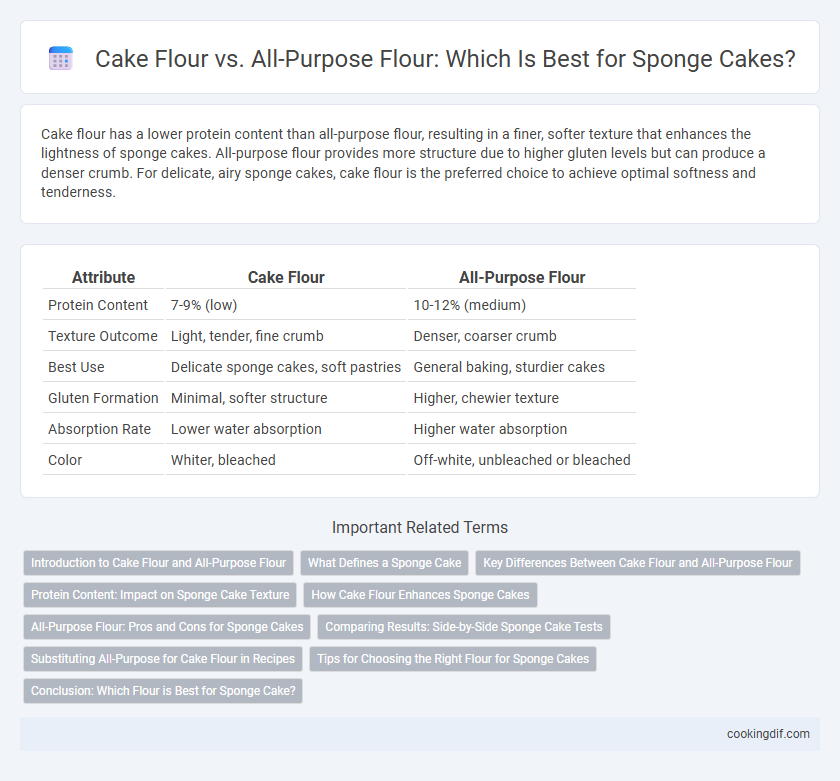Cake flour has a lower protein content than all-purpose flour, resulting in a finer, softer texture that enhances the lightness of sponge cakes. All-purpose flour provides more structure due to higher gluten levels but can produce a denser crumb. For delicate, airy sponge cakes, cake flour is the preferred choice to achieve optimal softness and tenderness.
Table of Comparison
| Attribute | Cake Flour | All-Purpose Flour |
|---|---|---|
| Protein Content | 7-9% (low) | 10-12% (medium) |
| Texture Outcome | Light, tender, fine crumb | Denser, coarser crumb |
| Best Use | Delicate sponge cakes, soft pastries | General baking, sturdier cakes |
| Gluten Formation | Minimal, softer structure | Higher, chewier texture |
| Absorption Rate | Lower water absorption | Higher water absorption |
| Color | Whiter, bleached | Off-white, unbleached or bleached |
Introduction to Cake Flour and All-Purpose Flour
Cake flour is a finely milled, low-protein flour with about 7-8% protein content, designed to create tender and delicate sponge cakes by producing less gluten. All-purpose flour contains around 10-12% protein, providing more structure but resulting in denser, chewier sponge cakes when used as a substitute for cake flour. Understanding the protein content and texture differences between cake flour and all-purpose flour is crucial for achieving the desired lightness and fluffiness in sponge cake recipes.
What Defines a Sponge Cake
A sponge cake is characterized by its light, airy texture achieved through the incorporation of well-beaten eggs or egg whites that trap air, providing natural leavening rather than relying on chemical agents like baking powder. Cake flour, with its lower protein content (typically 7-9%), produces less gluten, resulting in a tender crumb and delicate structure ideal for sponge cakes. All-purpose flour, higher in protein (about 10-12%), creates more gluten, yielding a denser, less airy sponge cake texture.
Key Differences Between Cake Flour and All-Purpose Flour
Cake flour, with its lower protein content (around 7-8%), produces a finer, softer crumb ideal for sponge cakes, while all-purpose flour has a higher protein level (10-12%), resulting in a denser texture. The lower gluten formation in cake flour creates a lighter, more tender cake, whereas all-purpose flour's gluten strength offers more structure but can make sponge cakes tougher. Using cake flour ensures increased moisture retention and a delicate rise, enhancing the airy quality essential in traditional sponge cakes.
Protein Content: Impact on Sponge Cake Texture
Cake flour contains about 7-9% protein, significantly lower than the 10-12% protein found in all-purpose flour, resulting in less gluten formation. This lower protein content in cake flour produces a finer crumb and tender, airy texture essential for sponge cakes. Using all-purpose flour can make sponge cakes denser and chewier due to its higher gluten strength.
How Cake Flour Enhances Sponge Cakes
Cake flour's lower protein content, usually around 7-8%, creates a finer, softer crumb in sponge cakes by producing less gluten compared to all-purpose flour, which has 10-12% protein. This results in a tender, airy texture with a delicate structure that enhances the cake's lightness and moisture retention. The finer milling and chlorination process of cake flour further improves its ability to absorb sugar and liquid, contributing to a superior rise and fluffiness in sponge cakes.
All-Purpose Flour: Pros and Cons for Sponge Cakes
All-purpose flour offers a balanced protein content of 10-12%, providing moderate gluten formation that supports sponge cakes in achieving a sturdy yet tender crumb. Its versatility makes it widely accessible and suitable for various baking needs, though it may yield a slightly denser texture compared to cake flour's finer, lower-protein composition. Using all-purpose flour in sponge cakes can result in a more robust structure but may require adjustments in mixing or leavening to maintain desired lightness and softness.
Comparing Results: Side-by-Side Sponge Cake Tests
Cake flour produces a lighter, fluffier sponge cake with a tender crumb due to its lower protein content compared to all-purpose flour, which yields a denser texture. Side-by-side tests reveal that cakes made with cake flour have finer, softer pores, enhancing moisture retention and overall softness. In contrast, all-purpose flour creates sturdier cakes with a coarser crumb, suitable for recipes requiring more structure.
Substituting All-Purpose for Cake Flour in Recipes
Substituting all-purpose flour for cake flour in sponge cakes requires adjustments to maintain the delicate texture, as cake flour contains lower protein content and produces softer crumb. To mimic cake flour, combine one cup of all-purpose flour with two tablespoons of cornstarch, sifting thoroughly to reduce gluten formation and preserve tenderness. This modification helps achieve the light, airy structure characteristic of sponge cakes, despite using higher-protein all-purpose flour.
Tips for Choosing the Right Flour for Sponge Cakes
Choosing the right flour for sponge cakes depends on the protein content, with cake flour containing about 7-8% protein, making it ideal for creating a light, tender crumb due to its fine texture and lower gluten formation. All-purpose flour, with 10-12% protein, produces a denser and chewier sponge, so it's best used when a sturdier cake structure is desired. For optimal results, sift cake flour to aerate and incorporate evenly into the batter, ensuring a delicate rise and soft texture in your sponge cake.
Conclusion: Which Flour is Best for Sponge Cake?
Cake flour, with its lower protein content (about 7-9%), creates a tender, fine crumb ideal for sponge cakes, while all-purpose flour's higher protein (10-12%) can lead to a denser, chewier texture. For sponge cakes requiring lightness and a delicate structure, cake flour produces superior results by minimizing gluten development. Choosing cake flour enhances the softness and height of sponge cakes, making it the preferred option over all-purpose flour.
Cake flour vs all-purpose flour for sponge cakes Infographic

 cookingdif.com
cookingdif.com